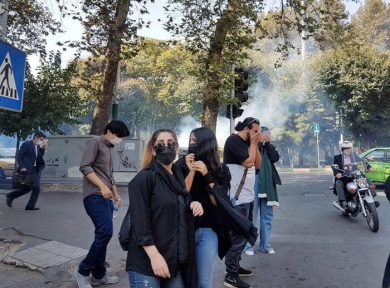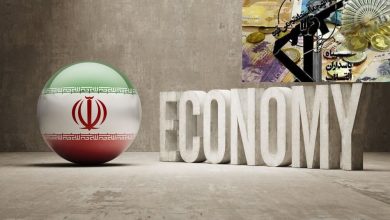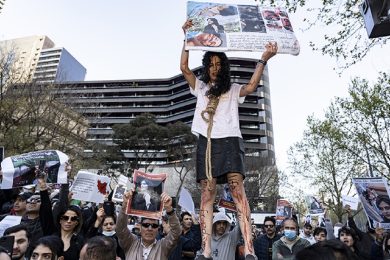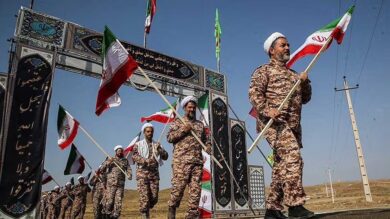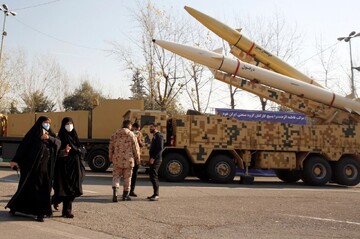The Islamic Revolutionary Guard Corps (IRGC) has played a decisive role in shaping the trajectory of the Syrian Civil War. From the conflict’s earliest days in 2011, the IRGC has acted as the lifeline for Bashar al-Assad’s regime, deploying a complex mix of military force, strategic alliances, and proxy warfare. While the IRGC presents its involvement in Syria as a defense of its ally and the region’s “stability,” its actions tell a different story—one of widespread terror, human rights abuses, and the exacerbation of sectarian divisions.
The IRGC’s influence in Syria extends beyond the battlefield. By propping up Assad, it has entrenched Iran’s geopolitical ambitions in the Levant, secured critical supply routes, and deepened the humanitarian crisis in a country already devastated by years of war. This post explores the multifaceted role of the IRGC in Syria, highlighting its tactics, terror actions, and the broader consequences of its involvement.
The IRGC’s Entry into Syria: Strategic Motives
The IRGC’s involvement in Syria began with the uprising against Bashar al-Assad in 2011, which rapidly escalated into a civil war. For Iran and the IRGC, Syria was more than an ally—it was a strategic linchpin in the “Axis of Resistance,” a coalition including Iran, Syria, Hezbollah, and other Iran-backed factions. Losing Assad’s regime would have meant losing a critical conduit for supplying Hezbollah in Lebanon and undermining Iran’s ability to challenge Israel and Western influence in the region.
The IRGC’s intervention was driven by three key objectives:
- Preservation of the Assad Regime: Ensuring Assad’s survival was critical to maintaining Iranian influence in the Levant.
- Expansion of Iranian Power: Syria provided a platform for Iran to project power regionally, including threatening Israel.
- Sectarian Dominance: The IRGC framed its involvement as a defense of Shiite Islam against Sunni “extremists,” exacerbating sectarian tensions.
Military Tactics and Proxy Networks
The IRGC’s role in Syria has been characterized by a mix of direct military intervention and the mobilization of proxy forces. This approach allowed Iran to mitigate the risks of deploying its regular forces while amplifying its influence on the ground.
Deployment of Quds Force
The IRGC’s elite Quds Force, under the late General Qassem Soleimani, spearheaded operations in Syria. The Quds Force coordinated military strategies, advised Syrian troops, and organized militias from across the region. Soleimani was frequently photographed on Syrian battlefields, symbolizing the IRGC’s deep involvement.
Recruitment of Foreign Fighters
One of the IRGC’s most controversial actions in Syria has been its recruitment of foreign fighters. Shiite militias from Afghanistan (Fatemiyoun Division), Pakistan (Zeinabiyoun Brigade), Iraq (Harakat al-Nujaba and Kata’ib Hezbollah), and Lebanon (Hezbollah) were mobilized, armed, and trained by the IRGC.
These militias acted as the regime’s shock troops, often deployed in brutal offensives against rebel-held territories. Their presence also turned the Syrian Civil War into a sectarian battleground, fueling animosity between Sunni and Shiite communities.
Use of Advanced Weaponry
The IRGC supplied Assad’s forces and its militias with advanced weaponry, including drones, missiles, and improvised explosive devices (IEDs). Iranian drones were used to surveil and strike opposition positions, often with devastating consequences for civilians.
Urban Warfare and Siege Tactics
The IRGC played a significant role in devising and executing siege tactics that led to massive civilian suffering. Areas like Aleppo, Homs, and Eastern Ghouta were subjected to starvation sieges, indiscriminate bombing, and ground offensives led by IRGC-backed forces. These tactics resulted in thousands of civilian deaths and forced displacements.
Terror Actions and Human Rights Abuses
The IRGC’s actions in Syria have been widely criticized for their disregard for human rights and their contribution to the humanitarian catastrophe in the country.
Civilian Targeting and Mass Killings
The IRGC and its proxies have been implicated in massacres targeting Sunni communities perceived as sympathetic to the opposition. These operations often involved summary executions, mass graves, and the systematic destruction of homes and infrastructure.
One infamous incident was the 2012 Houla Massacre, where IRGC-backed militias were accused of killing over 100 people, including children, in a brutal campaign of violence. Similar atrocities have been reported in other opposition-held areas.
Forcible Displacement and Demographic Engineering
The IRGC supported Assad’s strategy of forcibly displacing populations in rebel-held areas, often replacing them with Shiite families and militias loyal to Iran. This demographic engineering aimed to create a pro-Iranian corridor stretching from Damascus to the Lebanese border.
The displacement of millions of Syrians, combined with targeted destruction of Sunni-majority areas, has irrevocably altered Syria’s social fabric, sowing seeds of long-term instability.
Chemical Weapons and Cluster Munitions
While the Assad regime is primarily blamed for chemical weapons attacks, the IRGC’s logistical and operational support has been critical. Human rights organizations have accused IRGC-backed forces of facilitating the deployment of barrel bombs, cluster munitions, and other indiscriminate weapons, which have killed thousands of civilians.
Economic Exploitation and Sectarian Control
The IRGC’s influence in Syria extends beyond the battlefield into the country’s economic and political spheres. By leveraging Syria’s resources, the IRGC has sought to entrench its presence and fund its broader regional ambitions.
Control of Key Resources
The IRGC has established control over significant portions of Syria’s oil and gas infrastructure, using these resources to finance its operations. Through local front companies and partnerships with regime cronies, the IRGC has profited from Syria’s war economy.
Real Estate and Reconstruction
As areas have been “liberated” by IRGC-backed forces, Iran has invested in reconstruction projects designed to solidify its influence. These projects often prioritize Shiite-majority areas and exclude displaced Sunni communities, further exacerbating sectarian divides.
Religious Influence
The IRGC has sponsored the construction of Shiite shrines and religious institutions in Syria, aiming to export Iran’s ideological and theological vision. These efforts include expanding the role of Hezbollah and other Shiite organizations in Syrian society.
Impact on Regional and Global Stability
The IRGC’s actions in Syria have had far-reaching consequences beyond the country’s borders, contributing to regional instability and global security concerns.
Strengthening Hezbollah
Syria has long been a critical supply route for Hezbollah in Lebanon. The IRGC’s role in securing this corridor has strengthened Hezbollah’s military capabilities, enabling it to stockpile advanced missiles and prepare for potential conflicts with Israel.
Proxy Wars with Israel
The IRGC has used Syria as a base to challenge Israel directly, deploying drones and rockets targeting Israeli positions in the Golan Heights. These provocations have led to repeated Israeli airstrikes, raising the risk of a broader regional conflict.
Fueling Refugee Crises
The IRGC’s involvement has contributed to the displacement of millions of Syrians, creating one of the worst refugee crises in modern history. The mass exodus has strained neighboring countries and destabilized Europe, where refugee flows have fueled political polarization.
Empowering Extremism
While the IRGC claims to fight terrorism, its actions have often empowered extremist groups. By turning the Syrian Civil War into a sectarian conflict, the IRGC has fueled the rise of jihadist organizations, including ISIS and al-Nusra Front, which have exploited Sunni grievances.
The Cost of IRGC’s Involvement
The IRGC’s involvement in Syria has come at a significant cost for Syrians, the region, and the global community:
- Humanitarian Catastrophe: Over 500,000 Syrians have been killed, and millions displaced, largely due to the IRGC-backed regime’s tactics.
- Entrenched Iranian Influence: The IRGC has established a long-term presence in Syria, ensuring Iran’s strategic objectives are prioritized over Syria’s recovery.
- Global Tensions: The IRGC’s actions have escalated conflicts involving the U.S., Israel, and Gulf nations, increasing the risk of wider regional wars.
Conclusion
The IRGC’s role in Syria is a chilling example of how state-sponsored entities can exploit conflict to pursue their geopolitical ambitions at the expense of human lives and regional stability. By entrenching itself in Syria, the IRGC has not only prolonged the civil war but also exacerbated sectarian divides, empowered extremist groups, and created a humanitarian crisis of unprecedented scale.
Addressing the IRGC’s actions in Syria is not just a matter of holding Iran accountable—it is essential for the future stability of the Middle East and the security of the global community. As the world continues to grapple with the consequences of the Syrian Civil War, the IRGC’s role serves as a stark reminder of the dangers posed by unchecked state-sponsored terrorism and proxy warfare.
Join Our Newsletter!
Stay informed with the latest updates, news, and ways to take action in the fight for justice and global security. Sign up now to get updates delivered straight to your inbox!

